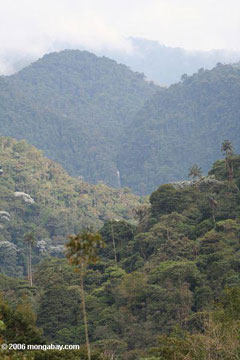Moving species may be only way to save them from climate change
Moving species may be only way to save them from climate change
Jeremy Hance, mongabay.com
July 17, 2008
Desperate times call for desperate measures, according to a new paper in Science. Conservation scientists from the US, the UK, and Australia are calling for the consideration of a highly controversial conservation technique: assisted migration. According to the policy piece, species would be relocated to sites “where they do not currently occur or have not been known to occur in recent history”.
The scientists believe certain species face such grave threats from climate change that the only way to save them from extinction may be assisted migration. As the globe warms, natural migration to favorable habitats will be impossible for many species — their paths blocked either by natural or human-made barriers. In their paper the researchers warn that “whole ecosystems, such as cloud forests and coral reefs, may cease to function in their current form.”
The researchers have set up parameters to help conservationists decide if a threatened species would be a good candidate for assisted migration. These include a full knowledge of the species’ habitat needs, whether or not the species would be easy to collect and transport, and if there is suitable habitat available elsewhere. In addition, social issues, such as the expense involved and the ‘value’ (monetary and/or aesthetic) of the species, would need to be taken into account.

|
The greatest challenge facing assisted migration, however, is determining the impact of the migrated species on its new environment. “The world is littered with examples where moving species beyond their current range into natural and agricultural landscapes has had negative impacts,” the scientists write, noting the example of the cane toad in Australia, which has had devastating effect on the environment and native species. The researchers state that before any decision can be made, conservationists must determine if the risk of extinction warrants the possible risks to the new environment. Only if the former is high and the latter low may assisted migration be a viable option.
“Passively assisting coral reef migration may be acceptable, but transplanting polar bears to Antarctica, where they would likely drive native penguins to extinction, would not be acceptable,” one of the researchers for the project, Professor Camille Parmesan, said.
Another member of the research team, Professor Chris Thomas, stated that the team was not advocating moving species across continents or over large bodies of water. “Moving species between continents caused all sorts of problems, and has given translocation a bad name amongst conservation organizations. But this is not what we are suggesting. Ecology has moved on a long way since then, and we now know that moving species within the same general region (e.g., from France to Britain) hardly ever causes serious biological problems. The time is fast approaching when we need to identify the species that might need to be protected.”

|
Despite the controversial nature of assisted migration, Parmesan says that more and more conservationists are considering the matter: “When I first brought up this idea some 10 years ago in conservation meetings, most people were horrified. But now, as the reality of global warming sinks in, and species are already becoming endangered and even going extinct because of climate change, I’m seeing a new willingness in the conservation community to at least talk about the possibility of helping out species by moving them around.”
If assisted migration proves impossible for any number of reasons, other last-ditch tactics may be employed. Scientists have suggested maintaining entire populations of species in captivity, along with using seed banks to preserve eggs and sperms for future breeding.
According to the researchers, however, the best thing for the world’s wildlife is to use all our means possible to mitigate the effects of climate change. “We can go so far with helping species to adapt to climate change, but ultimately we are not going to be successful if high levels of climate change take place,” Thomas stated.
O. Hoegh-Guldberg at al (2008). Assisted Colonization and Rapid Climate Change. Science 18 July 2008
Coral reefs decimated by 2050, Great Barrier Reef’s coral 95% dead (November 17, 2005)
Australia’s Great Barrier Reef could lose 95 percent of its living coral by 2050 should ocean temperatures increase by the 1.5 degrees Celsius projected by climate scientists. The startling and controversial prediction, made last year in a report commissioned by the World Worldwide Fund for Nature (WWF) and the Queensland government, is just one of the dire scenarios forecast for reefs in the near future. The degradation and possible disappearance of these ecosystems would have profound socioeconomic ramifications as well as ecological impacts says Ove Hoegh-Guldberg, head of the University of Queensland’s Centre for Marine Studies.













